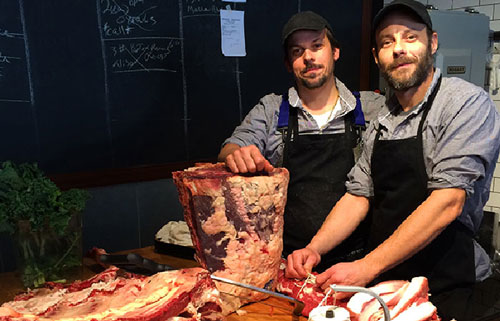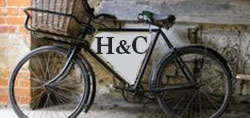A culinary destination in the West Village of Manhattan.
1. Some British and imperial outposts.
Hudson & Charles has occupied the small frontage at the crossroads its name describes for some two years. The family business is a welcome nook on a wintry day. The urban landscape around there is lovely, along with the culinary assets. The Brodo bone broth shop is a couple of doors down, South African Jonty Jacobs and its exceptional biltong just to the east on Christopher. Myers of Keswick has abided for ages ten minutes north by foot, the sometimes frosty and aloof but always indispensable outpost of British groceries in America.
The customer space at Hudson & Charles is, especially by Manhattan standards, an unlikely fraction of the whole. That is because some serious business occupies the butchers and cooks in the bigger area behind the counter. The people back there bring in whole carcasses to butcher themselves, make all their own ‘deli meats’ (no ‘charcuterie’ for these folks, their terminology is Old School New York) and grind fresh sausage too. Herbs and spice are organic.
2. The return of a heritage pig.
The Irish ham at Hudson & Charles is not really Irish, not in origin anyway, and barely ham at all. The pork comes from Autumn’s Harvest Farm in the Finger Lakes. Its owners, Sara and Tim Hawes raise Large Black, or Boggu, Pigs in a humane outdoor environment. They are not so much a heritage breed as a hybrid of English heritage breeds created during the nineteenth century from the West Country counties of Cornwall and Devon, and East Anglia.
Large Blacks followed the British Empire around the world onto every continent but their population reached a peak in the interwar period. Fortunately for them, Large Blacks do not thrive in the euphemistically named “intensive indoor farming” that amounts to sadistic incarceration. Unfortunately their numbers declined nearly to extinction as a result but beginning in the late twentieth century they have enjoyed a fragile revival of sorts, so in any number of ways the people at Autumn’s Harvest are doing well by doing good.
Hudson & Charles cures and boils its Irish ham themselves with what they call ‘warm spice,’ an underutilized and evocative term. It has little internet presence, limited chiefly to a California food cooperative and sites involving ayurvedic medicine.
Men at work.
3. The cure.
‘Warm spice’ has a couple of connotations. The ayurvedic one arises from a perceived notion that the spice increases body temperature in a beneficial manner analogous to a steambath or sauna. For us, however, the association is sensual in a different and distinctly nonmedicinal way, with comfort and homeliness in a cozy context. Comforting warm spice, in Irish or British usage, includes allspice, cinnamon, clove, coriander, mace, nutmeg and sometimes black pepper. Indian folk medicine broadens the scope to include most elements found in various curries; cardamom, cayenne, cumin, garlic and mustard in addition to the preternaturally English horseradish.
4. The ham.
As Jason Fox explains, they created the recipe for their ham in house. Lest the pious in our midst bleat about cultural appropriation, Hudson & Charles does have an Irish aspect. His husband and business partner comes from Northern Ireland, where butchers run in his family. The H&C ham is based on the memory of his uncle’s rendition, a recollection so fond and strong he and Fox were eager to replicate the style.
The result tastes as traditional, and traditionally good, as any ham emanating from Ireland itself, a place historically famed for its pork, where the national dish is boiled (unsmoked) bacon and cabbage. The H&C ham is unsmoked as well; the gentle cure barely colors the meat a faded pink, the flavor soothing and sweet. Hudson & Charles brines the pork for ten days then boils it, but only to an internal temperature of 150, which helps account for the delicate profile of the finished product. It sells for about $16 a pound, extraordinary value in New York or anywhere else.
5. Another, Dublin, fox.
By coincidence a Mr. Fox of comparable culinary accomplishment resides in Dublin. The welcoming restaurant stands below grade in a Georgian rowhouse on the unfashionable west side of Parnell Square in the unfashionable Dublin district north of the Liffey. That alone is reason enough to go but in addition the proprietors are as dedicated to Irish foodways as Hudson & Charles, if with a decidedly contemporary twist.
Mr. Fox is hardly immune to the transnational trends sweeping the serious restaurant industry. Its chipotle devilled eggs, buttermilk quail and yellowfin with ponzu line menus in North America and Britain as well as in Ireland, but pig’s head with smoked apple and celeriac; indigenous crab, smoked eel and kohlrabi; or especially venison with black pudding, celeriac, hispi (a kind of sweet cabbage) and pickled walnuts sound Irish, or in strictest culinary terms West British enough. Either way their sense of place is strong.
6. Grocery extraordinaire.
We digress. In addition to the food they fabricate themselves, Hudson & Charles offers lots of good things made by like-minded people. Compound butters and chutneys including seasoned sorrel jam from Stagg “a little company born in Louisiana raised in Brooklyn”) and Black & Bolyard brown butter with bay compete for space with a small selection of cheeses chosen well, including a variety from the nice people at Narragansett Creamery in Rhode Island.
As if any of this were not reason enough to seek out Hudson & Charles, a bank of taps at the front of the shop pumps a rotating selection of craft beers from microbrewers for filling growlers. Go, shop and buy.



